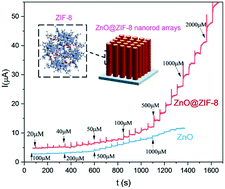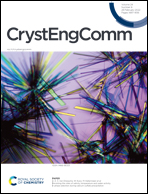Rational design of ZnO@ZIF-8 nanoarrays for improved electrochemical detection of H2O2
Abstract
Metal oxide nanostructures hold great promise in biosensors for non-enzymatic detection of H2O2. However, the interfacial or morphological changes of metal oxides during electrochemical reactions due to corrosion greatly reduce the service life and stability of the sensor. In this work, we propose the utilization of zeolite imidazole framework-8 (ZIF-8) as a functional layer to improve the H2O2 detection properties of ZnO nanorod arrays. Benefiting from the synergic interaction of the two materials, the core–shell ZnO@ZIF-8 nanoarrays demonstrate significantly enhanced electrochemical performance compared to pristine ZnO, delivering a wider linear range (20–11 550 μM) at 0.6 V potential, higher sensitivity (4.47 μA mM−1 cm−2) and low detection limit (3 μM), as well as appealing long-term stability of up to 21 days. Post-TEM analysis reveals that the ZIF-8 shells can effectively protect the ZnO cores from corrosion when immersed in electrolyte to detect H2O2. The core–shell structure formed by coating metal–organic frameworks on metal oxides provides a new pathway for high performance chemical detection and other related fields.

- This article is part of the themed collection: Editor’s Collection: Engineering Zeolitic Imidazolate Framework-8-based materials


 Please wait while we load your content...
Please wait while we load your content...